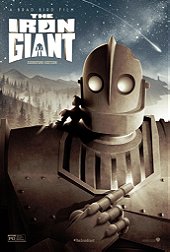A variation of the “boy and his dog” genre, but also something much deeper and more mature than that synopsis would suggest, The Iron Giant is a little movie with a powerful punch. Released in the summer of 1999, The Iron Giant was buried beneath an avalanche of Star Wars: The Phantom Menace and Austin Powers: The Spy Who Shagged Me blockbusters and sleeper hits like American Pie and The Blair Witch Project. Damn shame in retrospect, but quality will last and a cult quickly developed around the film.
I’m embarrassed it took me until thirty to finally watch this from beginning to end, but it holds up incredibly well and perhaps hit me in a deeper way than it would at twelve. Looking back, I don’t remember much of a marketing campaign for this, and maybe a rival studio was still afraid of even trying to compete with Disney’s gargantuan machinery as Tarzan was bound to steamroll anything in its path anyway. Yet, The Iron Giant is something that felt so profoundly engaging and like a direct connection to parts of my obsessions and visual aesthetics that bring me joy that I do miss not growing up with this.
No matter, I finally found it.
What immediately stood out to me was the delicate balance Brad Bird struck on his debut feature. He manages to tell a story with sincerity and sentimentality, but also to provide equal weight and validity to dangerous, scary moments and a sophisticated tone that never condescends to its family audience. Mercifully free from post-modern snark that was beginning to strangle the life out of these films, The Iron Giant is a smart, mature throwback in numerous ways.
Obviously, there’s the setting and all of the complicated emotional baggage it brings with it. 1950s America presented itself in its biggest films as a pastoral of impeccable grooming and booming economies, but a closer inspection reveals that the Norman Rockwell exterior was wrapped around post-war malaise and atomic age anxieties about potential nuclear destruction. The Iron Giant taps into these conflicting emotional states by placing the film in a small-town in Maine. This also provides an excuse for the various artist involved to fill the screen with as many autumnal colors as they can think of, and the entire film glows with the twinge of nostalgia.
Then there’s the ways it combines its two most obvious influences, Steven Spielberg and Hayao Miyazaki, in ways that find the commonalities between the two creative titans. The clear artistic progeny of E.T., The Iron Giant continues to explore the sentimentality and hardships of growing up, of making the big decisions in life when you’re possibly ill-equipped to fully understand their ramifications, and the story beat of people encountering the extraordinary and deciding to do something proactive about it. Yet it’s where and how Brad Bird takes these beats that make The Iron Giant so distinct.
Other films would lean into the Giant’s existence as a gigantic war machine and liter the film with explosions upon explosions, afraid that scenes of characters talking wouldn’t engage the little ones. Well, they can if they’re well done, and The Iron Giant has several action sequences dolled in sparse incriments that only add to the strength of the narrative or the dramatic tension, whichever is necessary at the time.
This is where Miyazaki’s influence is clearest: in the way that this film follows a different pace than most American animated films. It’s slower, it doesn’t beat the themes and messages over your head, nor does it make any single character completely virtuous or villainous. The world of the film resides in a grey zone that pushes back against the “beauty will best evil” reductive nature of so many of these things. I mean, the main bad guy is a Cold War agent who believes the huge metal war machine is a potential act of aggression and needs to be taken out, and you understand exactly where he gets that impression and why. You understand his actions and motivations, even if you don’t find yourself in agreement.
Yet The Iron Giant continually argues that we are who we chose to be, and never is that more effectively demonstrated than in the titular creation. His defiant proclamation that he is “not a gun” is a rousing moment of the ghost in the machine taking hold and claiming its own agency. His eventual sacrifice in the face of nuclear holocaust got me as we witnessed this rudimentary lunk of Fleischer-styled metal man grow a personality and perhaps a soul. We are who we chose to be, we can rage against our worst programming, we can grow and change. That’s some powerful stuff to dispel.
 Login
Login